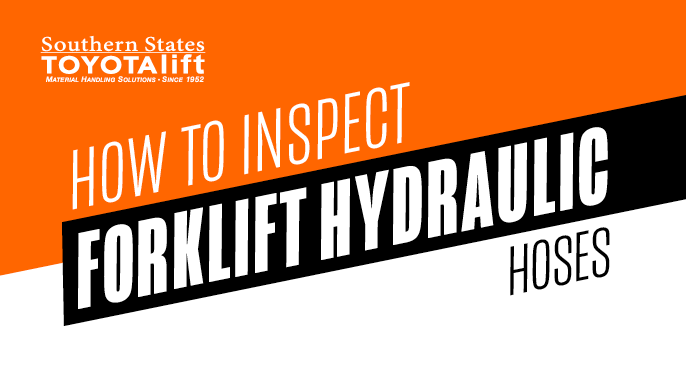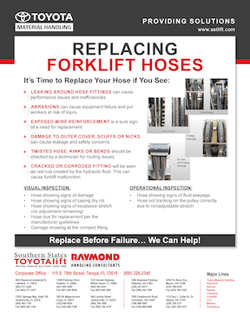How To Inspect Forklift Hydraulic Hoses
by Tony Letterman, on Jan 29, 2021 6:02:00 PM
 For busy warehouse managers, forklift maintenance is a constant area of focus. Limiting equipment downtime means your products get moved more quickly and efficiently, leading to lowered costs and increased profitability. Part of limiting downtime means pre-shift inspections and regularly scheduled maintenance.
For busy warehouse managers, forklift maintenance is a constant area of focus. Limiting equipment downtime means your products get moved more quickly and efficiently, leading to lowered costs and increased profitability. Part of limiting downtime means pre-shift inspections and regularly scheduled maintenance.
While major aspects of the forklift such as its mast chains, tires, carriage, and forks are part of its inspection, hydraulic hoses may be overlooked. If these core components are not properly maintained, they can cause decreased performance and even mast failure, potentially causing damage to products, racking, forklifts, and even harm to your employees. Here’s how you can make hydraulic hoses a key part of your inspection routine.
Signs Of Forklift Hydraulic Hose Damage
When’s the last time you looked closely at the hydraulic hoses alongside your forklift mast? If you haven’t looked lately, they may be showing warning signs of damage. If your forklifts are showing any of the following symptoms, it’s time to replace your hoses.
Leaky Hose Fittings
If your hydraulic fluid is leaky around hose fittings, it can affect your lifting performance. Lower fluid levels can take more energy to compensate, costing more fuel.
Scraping and Abrasions
If hoses get scraped or chunked due to casing damage, it can cause major equipment failure and put your workers at risk.
Fitting Cracks and Corrosion
Pay special attention to your hydraulic hose fittings - if these small metal components look cracked or corroded they can contribute to fluid loss and performance issues.
Twists, Kinks, and Bends
Issues in your hydraulic hose routing such as kinks or bends may be a simple fix for a technician, or they could be a sign of bigger problems.
Damage to Outer Covers
If your outer casing covers are nicked, dented, or damaged, it could cause issues for your hydraulic hoses too. These warning signs should be checked thoroughly to ensure they aren’t causing additional damage to hydraulic hoses.
Tips for Inspecting Forklift Hydraulic Hoses
When it comes to forklift hydraulic hoses, pre-shift operator inspections are a great way to catch some issues. Make sure that you train your inspectors properly to look for:
- Signs of leaking or corrosion
- Damage to covers and casing
- Twists or bends
- Scraping and chunking
Download a copy of our Solution Tip Sheet of Replacing Forklift Hoses
Your pre-shift checklist should include these items along with other key components. Any signs of trouble or performance issues should be reported to your maintenance team immediately. Along with visual inspections, your forklifts should be checked regularly as part of ongoing operational inspections. These more in-depth and hands-on inspections allow members of the maintenance team to check key details of hydraulic hoses and the rest of the forklift.
If your business is seeking a dedicated material handling maintenance provider, Southern States TOYOTAlift is here to help. Whether you need a dedicated parts supplier or someone to assist with forklift full maintenance, our team is trained and certified in the latest forklift best practices. You can contact us online, call us by phone at (800) 226-2345, or visit our material handling experts at one of our nine locations:
FLORIDA
Jacksonville
Ocala
Orlando
Tampa
Winter Park
GEORGIA
Albany
Macon
Midland
Valdosta









